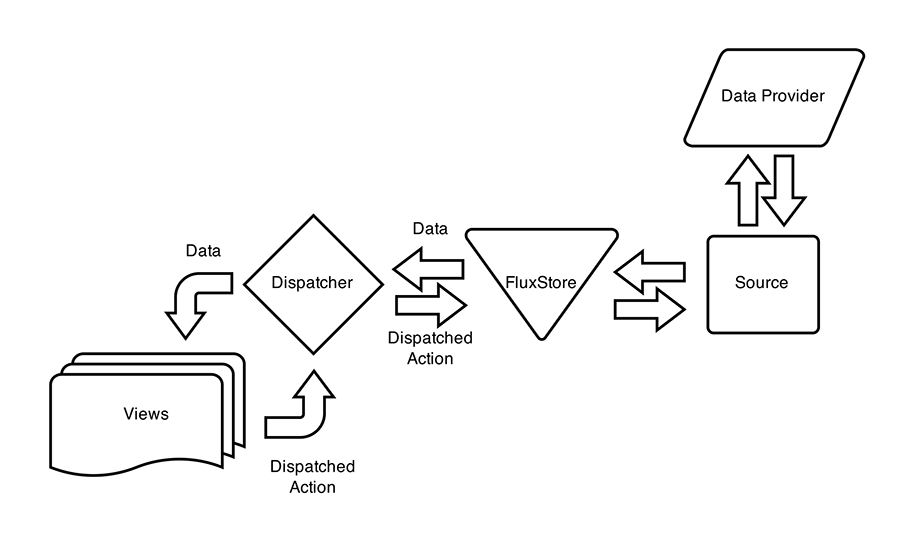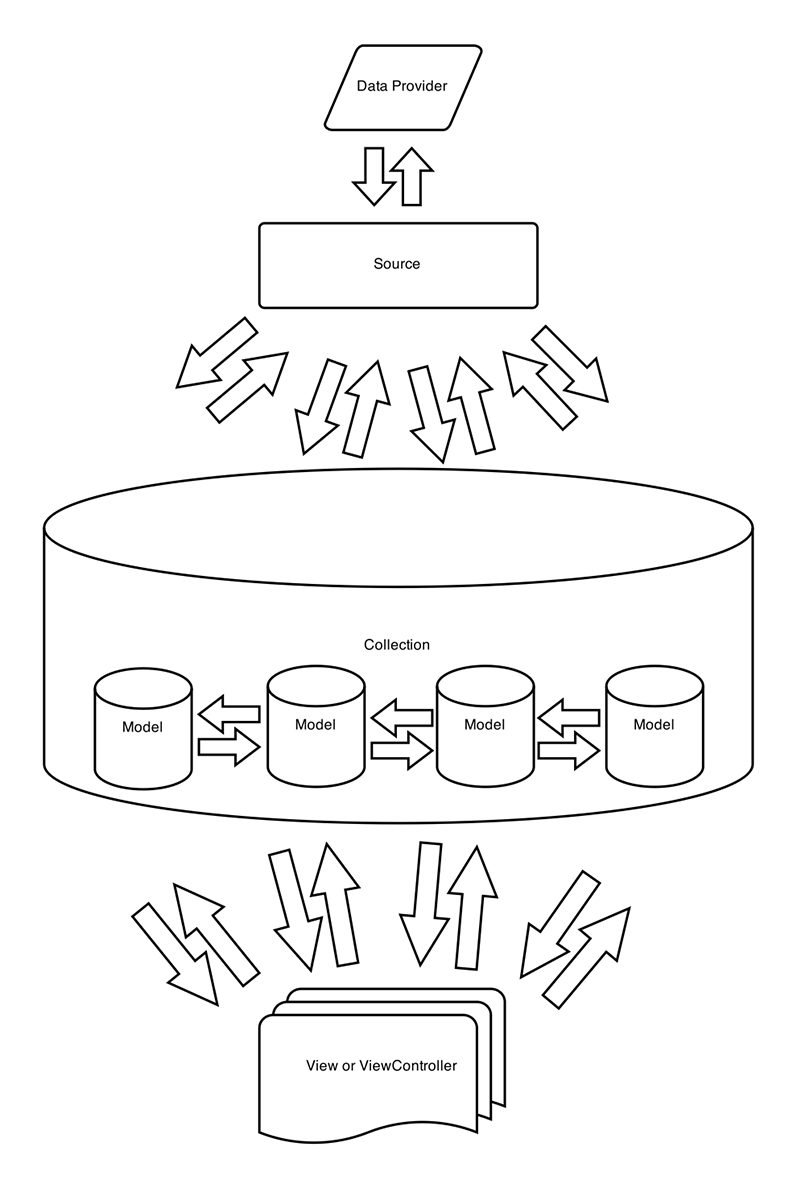Flux in Enyo
One of the new features included in Enyo 2.6 is support for the Flux application architecture. In this article, we look what Flux is, what it does, and how to use it in your Enyo application.
Please note that the code samples in this document are currently based on the Enyo framework's pre-2.7 (i.e., pre-modularized) state. We will update the code for compatibility with modularized Enyo in the near future.
What is Flux?
Flux is the process of flowing. In terms of application structure, it is a process of unidirectional data flow. When an app uses the Flux pattern, the one-way flow of data allows the view layer to be an immutable data structure for consumption.
What problem does Flux address?
As the number of models in an application increases and the relationships between models multiply, the different modules in the app may get out of sync regarding the state of the data. To address this issue, we have borrowed Facebook's Flux implementation and brought it into Enyo core.
Of course, Flux has other benefits beyond the elimination of data artifacts. For example, in a browser environment, a simplified process for delivering data to the UI can translate to faster rendering of that data.
In a traditional Model-View-Controller JavaScript environment, observer mechanisms monitor the data for changes and maintain the data's notification relationships. As the application and the data increase in complexity, so, too, can the observer scheme. Flux provides a way to minimize this complexity.
What does Flux look like?
The following graphic shows the data flow in a sample Flux application. Data consumers ask the dispatcher to pass Action requests (with payloads) to the data store. The payload may contain any meaningful data that a store needs to operate.

Flux Flow
How is this different from Enyo MVC?

MVC Flow
What are the downsides?
One of the central features of Flux is also one of its biggest potential downsides--the fact that, when a store's data changes, all consumers of the store's data are notified, even those whose underlying data has not changed.
In the React world, this works relatively well thanks to the differing mechanism used to build the DOM. As it turns out, this also works well in Enyo because we do not re-render components that are currently on drawn on the DOM.
Using Flux with Enyo
The Enyo framework's Flux support comes in the form of two new components, enyo/FluxDispatcher, and enyo/FluxStore.
FluxDispatcher is a singleton instance whose job is to usher data and route action requests across multiple stores and consumers.
FluxStore is an extendable traditional Enyo component. Each FluxStore should be modified to handle its unique requirements for data retrieval and modification.
When multiple coordinated FluxStores are needed, implement a Controller as a consumer of payload dispatches, to route multiple actions across stores.
Our First Store
To create our first store, we will extend enyo/FluxStore and define our Action handler inside of the update() method. We will also set the source property to an instance of enyo/Source to be consumed.
var
kind = require('enyo/kind'),
FluxStore = require('enyo/FluxStore'),
Source = require('enyo/Source');
var MyFluxStore = kind({
name: 'myapp.MyFluxStore',
kind: FluxStore,
source: Source,
update: function (actions) {
//handle actions dispatched to the store
}
});When a store instance is created, it will notify the dispatcher. In this case, we have departed from the general Flux pattern. An enyo/FluxStore will be assigned a dispatch id when created. We'll use this dispatch id to reduce the length of the potential notification stack.
Here's an example showing the FluxStore being created inside an application:
var
kind = require('enyo/kind'),
App = require('enyo/Application');
var MyApplication = kind({
name: 'myapp.Application',
kind: App,
create: function () {
this.inherited(arguments);
//create a new instance of the FluxStore
this.store = new MyFluxStore();
}
});Defining Actions
Of course, the update() method is not going to do us any good unless we define a set of actions that the FluxStore and a consumer will share. To do this, we create a singleton of static constants.
var kind = require('enyo/kind');
kind.singleton({
name: 'myapp.Constants.Actions',
myAction: 'myAction'
});This structure will allow the dynamic parts of our application, the Dispatcher and View, to communicate needed actions back to the FluxStore.
Creating a View
The Flux pattern requires a slight modification of the way you manage the view and its consumption of the data driving the interface.
var
kind = require('enyo/kind'),
utils = require('enyo/utils'),
FluxDispatcher = require('enyo/FluxDispatcher');
var MyView = kind({
name: 'myapp.MyView',
create: function () {
this.inherited(arguments);
this.subscriptionID = FluxDispatcher.subscribe(
this.app.store.id, //the store provides this ID
utils.bind(this, this.update)
);
},
update: function (payload) {
//interact with the fetched data here
if(payload.fooNode) {
this.$.SomeControl.set('content', payload.fooNode.foo);
}
}
});The view is subscribed to the FluxStore via its dispatch ID. The update() method is provided as the callback to the dispatcher. When the specific store's notification is invoked, the update() method will be passed the entire data set.
Because each consumer's update() method will be invoked, we must be sure to guard against evaluations that we do not want to take place. Without the proper guard code, you will likely encounter numerous property of undefined errors.
Sending Actions to a Store
Now that we have a pattern for bringing the data from the FluxStore to the View, how will we get the View to send updates back to the FluxStore?
We'll utilize the FluxDispatcher and the actions we previously defined. Let's suppose that our view contains a button; when the button is clicked, we use the ontap event to invoke a method called tapHandler().
tapHandler: function (sender, ev) {
//notify the store an action took place
//pass it the data needed to modify data
FluxDispatcher.notify(
this.app.store.id,
{
actionType: myapp.Constants.Actions.myAction,
payload: {
'bar'
}
}
);
}The dispatcher passes this as a payload to the FluxStore. The store's update() method is invoked, and we determine how to handle the data based on the passed-in action.
var
kind = require('enyo/kind'),
FluxStore = require(enyo/FluxStore),
Source = require('enyo/Source');
var MyFluxStore = kind({
name: 'myapp.MyFluxStore',
kind: FluxStore,
source: Source,
update: function (action) {
//handle dispatched actions to the store
switch(action.actionType) {
case myapp.Constants.Actions.myAction:
this.handleMyAction(action.payload);
break;
default:
//default code block
}
},
handleMyAction: function (data) {
//do something here with your source
}
});Interacting with Multiple Stores
What if you need to implement an action against more than one store? In this case, we can create a Controller that listens for notifications. The Controller may either listen to an existing notification stack or create its own stack.
var
kind = require('enyo/kind'),
FluxDispatcher = require('enyo/FluxDispatcher'),
Controller = require('enyo/Controller');
var MyActionController = kind({
name: 'myapp.ActionController',
kind: Controller,
create: function () {
this.inherited(arguments);
this.subscriptionID = FluxDispatcher.subscribe(
this.app.storeA.id, //the store provides this ID
this.bind(this, this.update)
);
},
update: function (action) {
switch(action.actionType) {
case myapp.Constants.Actions.myCompoundAction:
FluxDispatcher.notify(
this.app.storeA.id,
myapp.Constants.Actions.myAction,
action.payload);
FluxDispatcher.notify(
this.app.storeB.id,
myapp.Constants.Actions.myAction,
action.payload);
break;
default:
//default code block
}
}
});Our ActionController will listen the storeA stack for notifications. When a CompoundAction is sent, the ActionController will dispatch Actions to the appropriate stores.
Working with Dependent Stores
In instances where a compound action may take place, you may have a need to interact with multiple stores, based on dependency.
In such a situation, a store may use the waitFor() method provided by enyo/FluxDispatcher. This method is invoked inside a dispatching method like update(). When waitFor() is used, the independent store's update() method will complete before the dependent method is invoked.
var
kind = require('enyo/kind'),
Source = require('enyo/Source'),
FluxDispatcher = require('enyo/FluxDispatcher'),
FluxStore = require('enyo/FluxStore');
var StoreB = kind({
name: 'myapp.StoreB',
kind: FluxStore,
source: Source,
update: function (actions) {
FluxDispatcher.waitFor(this.app.storeA.id,
function () {
//complete the action here after storeA.update
}
)}
});Summary
The Flux pattern is an improved approach for dealing with complex relational data.
The flow of data from the Control layer to the View layer is streamlined through the use of a wider Model.
All data handling is funneled to, and all handling methods are encapsulated in, the FluxStore. The store is responsible for holding the data, modifying the data, and interacting with the source of the data.
If we need to interact with multiple FluxStore instances, we can use an Controller that is configured to consume Compound Action notifications from the FluxDispatcher, and to dispatch Actions through the FluxDispatcher to the appropriate stores.
If we know that one FluxStore is dependent on another FluxStore, we can use FluxDispatcher.waitFor() inside the store's update() method to ensure that the independent store completes its update first.
